Benefits of Booking Everest Base Camp with Helicopter Return
Booking an Everest Base Camp (EBC) trek with a helicopter return is an ideal option for those with limited time, seeking comfort, or looking for a memorable adventure. It offers several benefits, combining the adventure of trekking with the comfort and convenience of a helicopter flight.
Firstly, you can save time. The classic Everest Base Camp Trek takes about 12 days, but with a helicopter return, the trek takes only 8 days because you will have a direct flight from Gorakshep instead of trekking back the same route.
This option provides comfort upon arrival in Kathmandu, as you will avoid the long descent. The return trek from EBC involves a long descent, which can be physically demanding and boring. A helicopter ride eliminates this, reducing the physical strain and avoiding the risk of altitude sickness, which might develop during a prolonged stay at high altitudes.
Additionally, the helicopter ride offers breathtaking panoramic views of the Himalayas, including Mount Everest, Ama Dablam, and other peaks. This unique perspective is a highlight of the trip. Combining trekking with a helicopter ride adds a layer of adventure and luxury, making your trip even more memorable.
Reach to Lukla by Airplane
Lukla is the small town that serves as the starting point for the EBC trek with a helicopter return. It has a small airstrip where many planes land from Kathmandu and Ramechhap during the busy trekking season. The airstrip is named Tenzing-Hillary Airport, Lukla. Regular flights to Lukla are operated by Tara Air, Summit Air, and Sita Air from both Kathmandu and Ramechhap. There is no road connection from Kathmandu to Lukla, so trekkers must either fly there or trek from Phaplu or Jiri.
Regarding luggage weight: there is a luggage weight limit on small planes. You need to ensure that your total luggage weight, including your hand-carry bag, does not exceed 15 kg; otherwise, you will have to pay extra. We suggest keeping your luggage weight under 15 kg. Sometimes, if the plane is overloaded, you may have to fly without your baggage, which will arrive on the next flight.
Please be aware that taking a smaller aircraft for the flight to Lukla involves navigating the narrow Himalayan area, crossing many high hills. Occasionally, bad and critical weather might delay your journey to and from Kathmandu-Lukla-Kathmandu or Ramechhap-Lukla-Ramechhap. The weather in the Himalayan and hilly regions can change very quickly, causing flight delays. This can extend your journey, so you should plan for a few extra days before and after the trekking days in your itinerary. However, we will try to create the best possible itinerary, considering potential flight delays and cancellations.
If you do not have extra time before and after the trekking itinerary, you may need to take a helicopter to fly near Lukla, but good visibility is required for helicopter flights. Alternatively, you could shift the trekking route to another region. We have extensive experience with such situations and always strive to provide the best service for trekkers who book the EBC trek with a helicopter return with us.
Food and Accommodation for EBC Trek with Helicopter Return
Before planning an Everest Base Camp (EBC) trek with a helicopter return, it is important to know about the types of food and accommodation services available along the trek. The Everest region is a popular trekking destination in Nepal, with well-managed trails maintained by Sagarmatha National Park.
Along the EBC trek, there are many accommodations and restaurants due to the busy trekking trail, with new houses being added each year to provide more rooms for trekkers up to Dingboche. However, accommodations become limited at higher altitudes, particularly in Lobuche and Gorakshep.
You can easily find comfortable accommodation up to Dingboche, where most tea houses strive to provide the best service for all travelers. Typically, lodges offer private rooms (with two beds per room) and shared indoor bathrooms. If you need luxury facilities, there are a limited number of luxury lodges in a few locations. The quality of lodges varies, so you can choose based on your budget.
Regarding food, every lodge has a menu, and the food items are almost the same across different lodges. We strongly recommend trying the typical Nepali dish "Dal Bhat" (boiled rice, vegetables, and lentil soup). However, you can choose other items from the menu as well. Most lodges grow fresh vegetables in their gardens and serve them to customers. While the cooks are trained, the taste of the food might be slightly different from what you are used to in the West. Since meat is not fresh in the mountain areas, it is advisable to be vegetarian during the Everest Base Camp trek with a helicopter return.
You can buy all types of drinks in every lodge, but prices increase as you go higher. You can drink normal water using purification tablets. It is best to avoid alcoholic drinks when you go to higher altitudes.
Best Season for EBC Trek with Helicopter Return
There are two main trekking seasons in Nepal: the autumn trekking season (September to December) and the spring trekking season (March to May). These are the best times for the Everest Base Camp Trek with a helicopter return trip. Additionally, the period from the beginning of September to the end of May is also recommended for this trip. These seasons offer the most favorable weather conditions and clear skies, enhancing both the trekking experience and the scenic helicopter ride. The weather is typically sunny and warm with clear skies, providing wonderful mountain views, clean air, and no rain. Longer days provide more time for trekking and enjoying the scenery and snow compared to other trekking seasons.
However, if you wish to avoid crowds and enjoy some solitude with nature and culture, winter (January and February) could also be an option. The temperature during winter may be a bit cold for most trekkers, but the visibility is generally good. The summer season (June to August) is rainy, which is ideal for nature lovers but offers poor visibility for helicopter and airplane rides.
Therefore, you can choose the best season for the Everest Base Camp Trek with a helicopter return depending on your vacation schedule.
EBC Trek with Helicopter Return difficulty
The difficulty level of the Everest Base Camp Trek with a helicopter return trip is considered moderate to challenging due to its high-altitude terrains. There is no road access, and it is difficult to reach Lukla, which is the starting and ending point of the trek. Lukla is situated at an altitude of 2,800 meters above sea level, and the trek reaches Kala Patthar, which stands at 5,545 meters above sea level. The daily walking distances range from 5 to 8 hours, and there are many obstacles during the EBC trek with a helicopter return trip.
This trip is difficult for those without previous high-altitude trekking experience and for beginners. To make the trip comfortable, it requires physical and mental strength and fitness to successfully complete the trek. Otherwise, it will be a very challenging trip.
During the main trekking season, you must book accommodations in advance because there are not enough accommodations for the many trekkers. This can make it difficult to find a place to stay, but your guide will manage everything you need. If you choose to do this trek in winter or summer, you need to prepare with proper cold and rain gear, as the weather can be extremely cold and wet. During the monsoon season, trekking trails in this region can become slippery and tough.
Overall, having an experienced guide, staying in tea houses, taking rest days for acclimatization, walking slowly, and taking short, easy steps will help minimize the difficulty of the Everest Base Camp Trek with a helicopter return trip.
Acclimatization day to reduce the Altitude Sickness for the Trip
An acclimatization day is necessary to reduce the risk of high-altitude sickness during the 12-day Everest Base Camp Trek with a helicopter return trip. This trek takes place in a remote, high-altitude area of the Everest Region, starting at 2,800 meters and reaching Everest Base Camp at 5,364 meters and Kala Patthar at 5,545 meters. Along the way, trekkers pass through beautiful Sherpa villages, forests, and other high-altitude landscapes. As you ascend, oxygen levels and air pressure decrease compared to sea level. Once you reach an altitude above 3,500 meters, you may experience symptoms of altitude sickness, such as nausea, vomiting, diarrhea, headaches, loss of appetite, tiredness, dizziness, and sleeplessness.
Namche Bazaar and Dingboche are designated as our acclimatization rest day in the itinerary for Everest Base Camp Trek with Helicopter Return Trip. This rest day help prevent altitude sickness and allow you to adapt to the environment. If you experience any symptoms of altitude sickness during the journey, it is important to address them immediately to avoid difficulties in completing the. To prevent these issues, you should follow your guide's instructions, as they are knowledgeable about high-altitude sickness.
To prevent altitude sickness, you should follow the itinerary closely, as proper acclimatization helps your body adapt to higher elevations. Additionally, stay hydrated by drinking plenty of water, eat a well-balanced diet with sufficient carbohydrates, maintain a comfortable pace, and avoid alcohol and sedatives.
When ascending on the 3,500 meters, be honest with your guide about how you are feeling. Your guide will advise you to walk slowly and may suggest that you sleep at a lower altitude before ascending further. This practice, known as acclimatization, helps reduce the risk of altitude sickness. However, if you continue to feel unwell despite following these recommendations, you should return to a lower altitude.
Requires Permits & Permits Cost for the Trek
The Everest Base Camp Trekking with Helicopter Return Trip route is situated within the Sagarmatha National Park in the Khumbu Pasang Lhamu Rural Municipality in the Everest region of Nepal. Therefore, you need to purchase a Sagarmatha National Park entrance permit and a Khumbu Pasang Lhamu Rural Municipality entrance permit. Another required permit is the TIMS (Trekkers Information Management System) card, which is for your safety and security, as it helps keep track of trekkers' whereabouts in the region. Both permits are mandatory for the Everest Base Camp Trek.
These permits can be obtained from a reputable trekking company, the Tourism Board (Bhrikuti Mandap), Kathmandu. The Sagarmatha National Park entrance permit can be buy in Monjo and Khumbu Pasang Lhamu Rural Municipality entrance permit can be purchased in Lukla after starting the journey. You or your guide must carry these permits throughout the trek, as you will need to show them and register at every checkpoint along the trail. If you attempt to trek without these permits, you will need to purchase them on-site at double the cost (as a penalty) or you may be forced to turn back. Requiring permits are given below:-
Khumbu Pasang Lhamu Rural Municipality entrance permits
- Cost: US$ 30 per person, per trek for all foreigners
- Cost: US$ 20 per person for SAARC (South Asian Association for Regional Cooperation) citizens
TIMS (Trekkers Information Management System) Card:
- Cost: US$ 20 per person, per trek
Sagarmatha National Park Entrance Fees:
- Cost: US$ 30 per person, per trek for all foreigners
- Cost: US$ 15 per person for SAARC (South Asian Association for Regional Cooperation) citizens
EBC Trek and Return Heli Trip Cost
The cost of the Everest Base Camp (EBC) trek with a helicopter return depends significantly on the package and services you choose. Factors influencing the cost include the duration of the trek, the level of comfort you prefer, whether you hire a guide and/or porter, and your choice of transportation. We offer affordable prices with the best service for all trekkers who choose to trek with us. This package spans 12 days, from your arrival to your departure from Nepal. For our 12-day itinerary, the cost ranges from US$ 2,500 to US$ 5,000, depending on the group size. This cost covers transportation, accommodation, food, guide, porter, and required permits for the trip.
However, it does not include emergency evacuation, drinks, or extra luxury accommodation. It is recommended to obtain detailed quotations from several reputable trekking agencies to compare and choose the best option that suits your needs and budget. We guarantee to provide you with reasonable costs and high-quality service for the EBC trek with helicopter Return trip within the above range. Additionally, we offer competitive and transparent pricing with no hidden costs, ensuring you get the best value for your money. Our packages include all essential services, making your planning and budgeting straightforward and hassle-free.
Luggage Load Carried by Porters during the Trek
If you are doing Everest Base Camp Trek with Helicopter Return trip with just a guide, it will be a cheaper journey, but the guide will not carry your luggage because they are professionals and have their own luggage to carry. In this case, you can hire a porter-cum-guide who handles both guiding and carrying your luggage, typically about 10 to 12 kg.
If you are in a group, we usually assign one porter for every two trekkers, so each trekker's luggage should weigh around 10 kg. If you hire a Porter, a porter typically carries 20 to 25 kg during the trek in Nepal. Trekking with both a guide and a porter highly recommended because they makes walking easier and gives you more free time to enjoy the trekking and climbing, resulting in a memorable trekking experience in Nepal during the Everest Base Camp Trekking with Helicopter Return trip.
Internet & Mobile Network service in the EBC with Helicopter Return Trip.
Internet and mobile network services are available along the Everest Base Camp with Helicopter Return trip but that can be unreliable and expensive as you ascend. During this trip having access to internet and mobile network services can enhance your experience by keeping you connected with family, friends, and emergency services.
Most of the teahouses along the EBC trek offer Wi-Fi service for an extra fee. The quality of the Wi-Fi connection is generally better at lower altitudes like Namche Bazaar. As you ascend, the connection might become slower and less reliable. The cost of Wi-Fi ranges from NPR 500 to 100 for a whole night, depending on the location.
Regarding mobile network service, the main providers in Nepal are Ncell and Nepal Telecom (NTC). Both have network coverage along the EBC trek, but coverage can be spotty at higher altitudes. The mobile network is primarily for voice calls and not for 4G data. If you do not have internet service in an emergency, our guide will help you pass messages as our guide always carries a cellular phone and stays in contact with our Kathmandu trekking office to update them about the trek and your health condition.
Traveling is an important part of life, so we ensure your safety and health during trekking in Nepal. Nowadays, you can get a local SIM card at Kathmandu airport upon arrival to use 3G and 4G internet services, as most trekking routes in Nepal have mobile network service.
Travel insurance and insurance policy for EBC Trek with Heli Return
Travel insurance is important for the Everest Base Camp (EBC) trek with a helicopter return, as it covers a wide range of potential risks including high-altitude sickness, flight cancellations, medical emergencies, and evacuation costs. This is crucial because the journey involves high-altitude terrains, and the Himalayan climate can change very quickly, increasing the risk of high-altitude sickness.
The EBC trek with a helicopter return trip is located between 2,800 to 5,545 meters, making travel insurance essential. If an accident occurs during the trip and requires medical attention or evacuation, the cost of returning to a city and receiving treatment may be significant. Therefore, you must ensure that your insurance covers the cost of an air ambulance, medical care, and any travel-related risks such as delayed flights and lost stolen, damaged, or missing baggage. Your insurance policy should cover your complete itinerary while visiting Nepal, including hikes higher than 5,500 meters. If not, you will be responsible for all unforeseen costs associated with your trek through Nepal.
All trekkers must send a copy of their comprehensive travel insurance policy certificate to High Pass Adventure as part of the booking process for trekking and climbing in Nepal. This ensures that all necessary coverage is in place for a safe and secure journey.
Tipping information
The trekking and climbing guide, as well as the porter, is essential to the success of the trip, ensuring that it is completed smoothly and without issues. Tipping is an important aspect of trekking in Nepal, as it acknowledges and appreciates the hard work of the local staff who assist you throughout your journey. It is customary to tip at the end of the trek, and you should gather all team members (guide, porter, assistant guide) together to distribute the tip. Tips are generally given in cash, preferably in US dollars or Nepalese rupees, and it is best to use small denominations to facilitate easier distribution
While the typical guideline is to tip around 10% of the total payable amount, you can adjust this based on the quality of service provided. Recommended tipping amounts are as follows:
- Guide: $12-$15 per day
- Climbing Guide: US$ 80 total
- Porter: $8-$10 per day
- Assistant Guide: $8-$12 per day
These tips are highly recommended to motivate the team and reward them for their outstanding service, contributing to a memorable and inspiring experience.
Packing List for EBC Trek with Helicopter Return
Packing for the Everest Base Camp Trek with a helicopter return trip requires careful consideration to ensure you have everything you need while keeping your pack as light as possible. Only 15 kg of your stuff is allowed on the plane, including hand carry, so only bring the necessary items. You can also rent or purchase trekking gear in Kathmandu if you don't have everything you need.
Here's a recommended packing list:
Clothing:
- Lightweight trekking pants
- Long-sleeved shirts
- T-shirts
- Down jacket
- Waterproof and windproof jacket
- Waterproof and windproof pants
- Thermal base layers (tops and bottoms)
- Warm hat and gloves
- Sun hat or cap
- Sunglasses with UV protection
- Hiking socks
Footwear:
- Sturdy hiking boots
- Camp shoes or sandals
- Micro Crampons
- Gaiters
Accessories:
- Daypack
- Trekking poles
- Headlamp or flashlight with extra batteries
- Power Bank (Portable charger or solar charger)
- Water bottle or hydration system
- Trekking towel
- Personal toiletries (toothbrush, toothpaste, biodegradable soap, etc.)
- Sunscreen and lip balm with SPF
- Personal first aid kit
Other Gear:
- Sleeping bag (comfortable to 10°C)
- Backpack rain cover
- Duffel bag or backpack for porters to carry your gear
- Personal identification and travel documents
- Travel insurance policy
- Snacks and energy bars



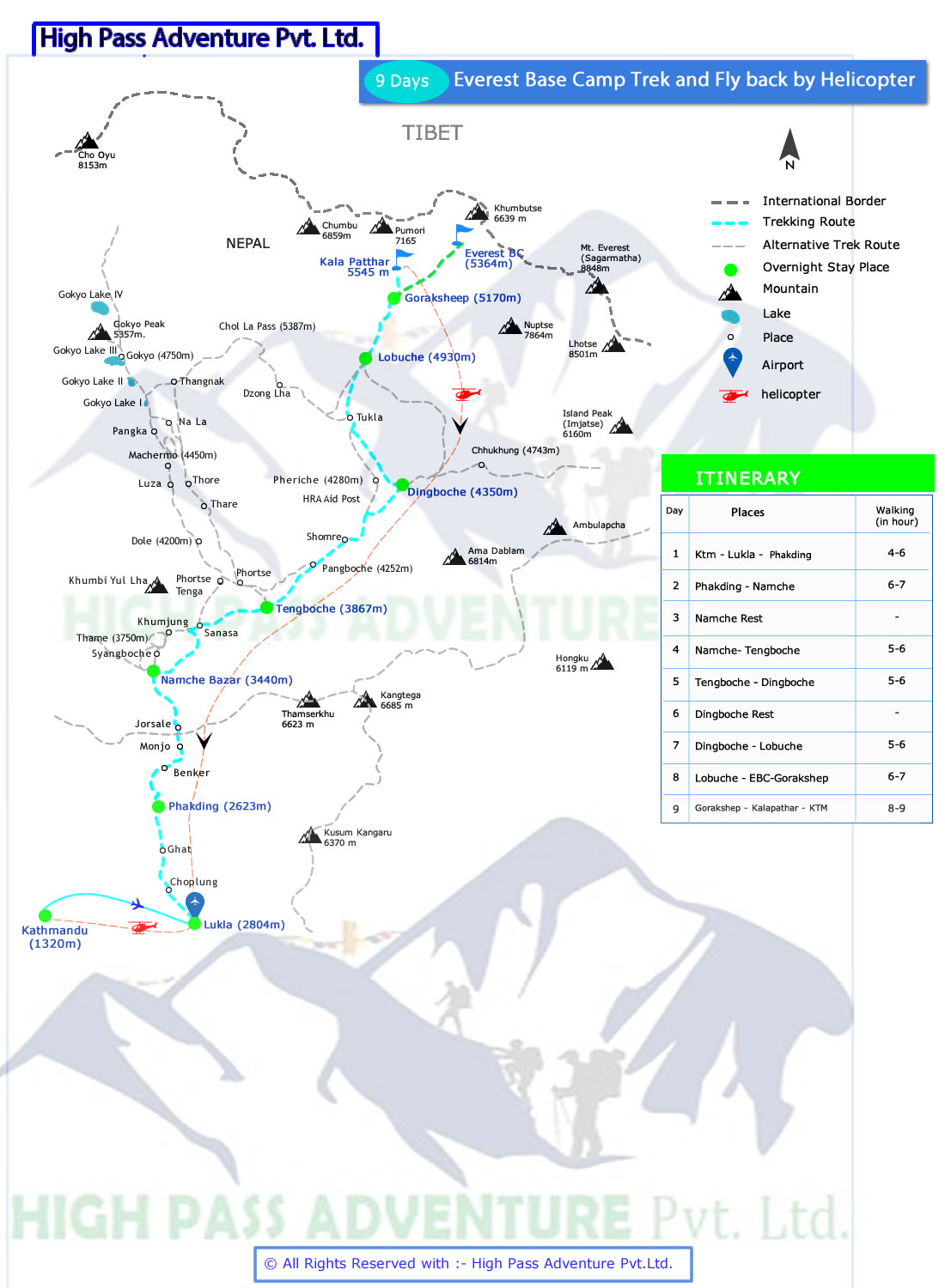



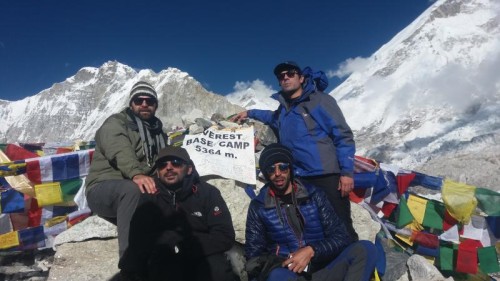
 USD 1340
USD 1340
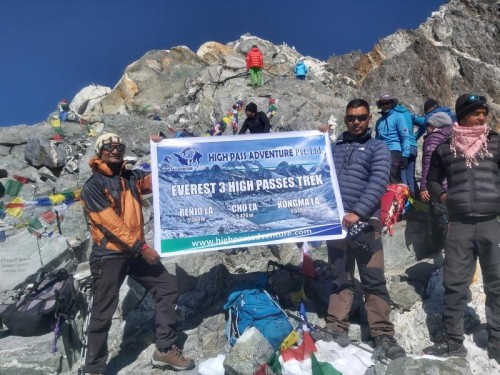
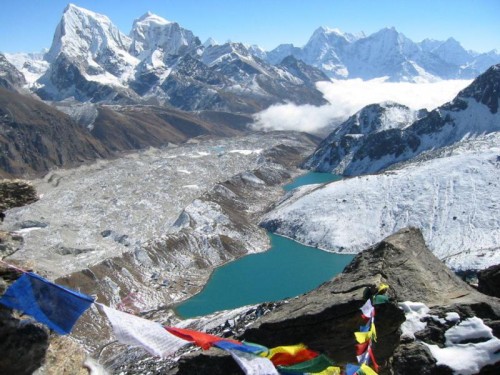
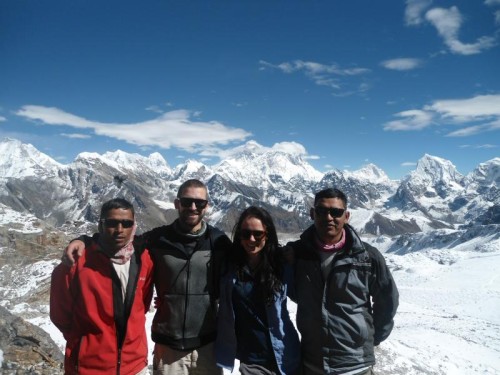

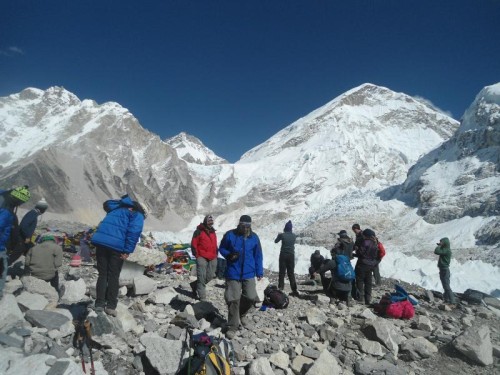
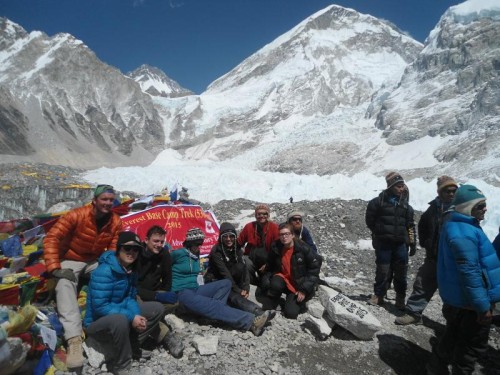

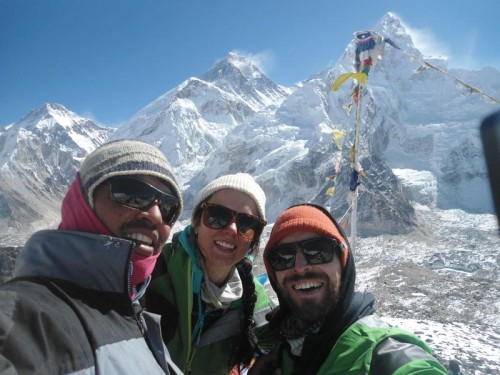
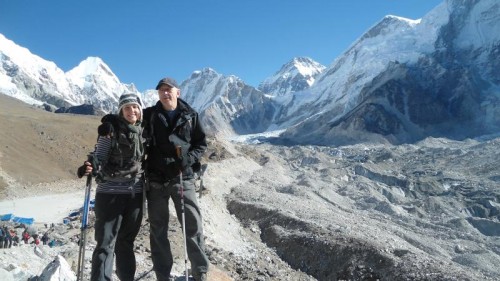
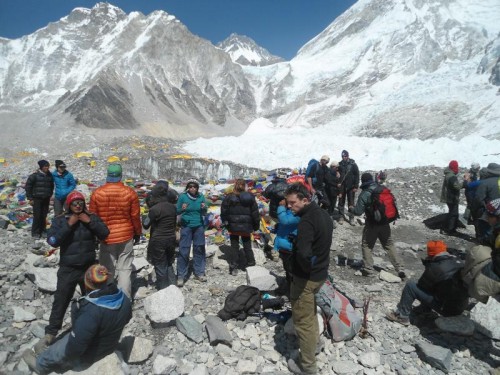
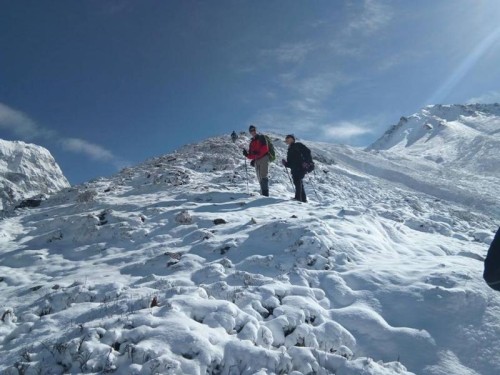

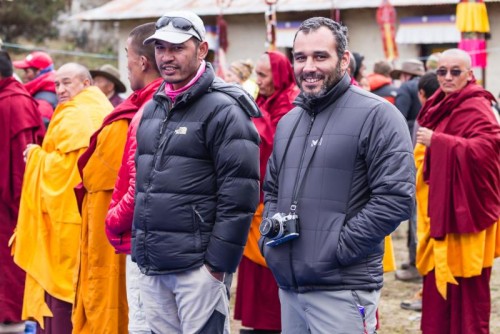
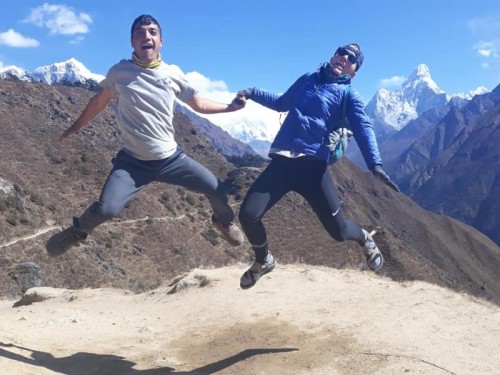

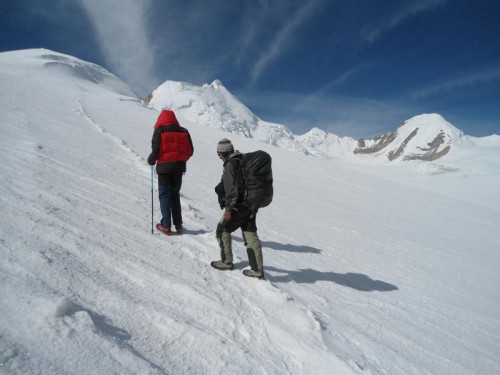

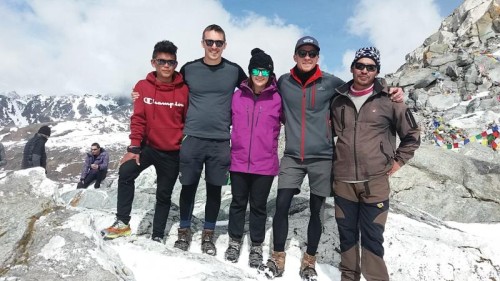

Nikhil
India
A Perfect Everest Base Camp Trek with a Scenic Helicopter Return to Lukla
16th June, 2025
We were a group of 9 people who completed a 7-day trek to Everest Base Camp, followed by a scenic helicopter return to Lukla on Day 8. This unforgettable trip was organized by High Pass Adventure, and it was truly an once-in-a-lifetime experience. Everything was perfectly arranged, and the team—Ganesh, Sundar, and Gyan—provided excellent support throughout the trek.
Their deep knowledge of the trail and ability to adapt to the group’s pace made the journey enjoyable for everyone. The trek was exhilarating, with breathtaking views at every turn. Memorable places like Namche Bazaar, Dingboche, Lobuche, and Everest Base Camp left a lasting impression—made even better by the perfect weather during our trip from June 7 to 14, 2025.
The helicopter ride back to Lukla offered a stunning aerial perspective of the Khumbu region like nothing else. Our return flight to Kathmandu was also smooth, giving me time to reflect on the incredible journey.
Big thanks to High Pass Adventure and the entire team for their flawless coordination. Their professionalism and passion made this adventure one I’ll remember for a lifetime. Highly recommended to all!